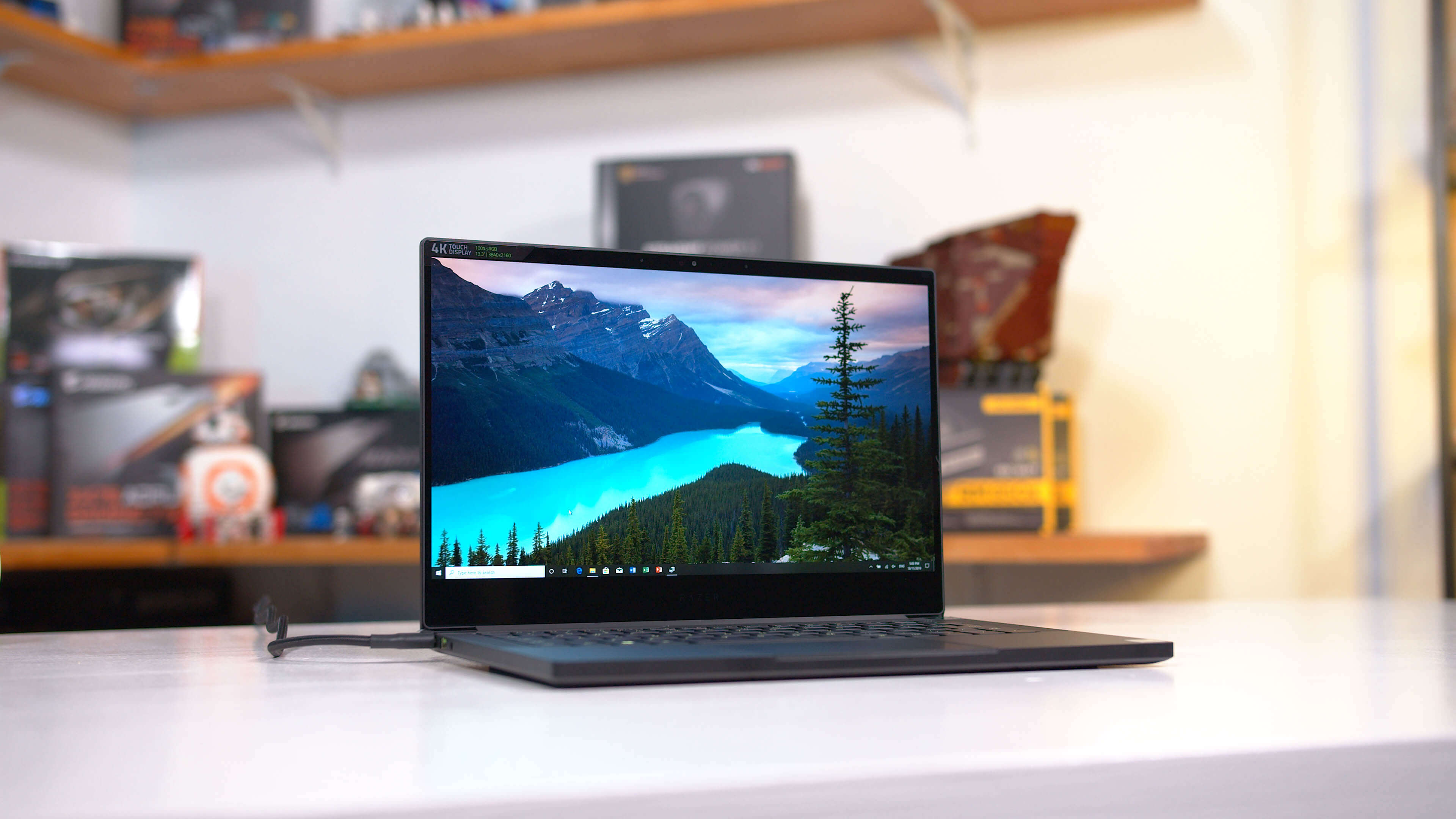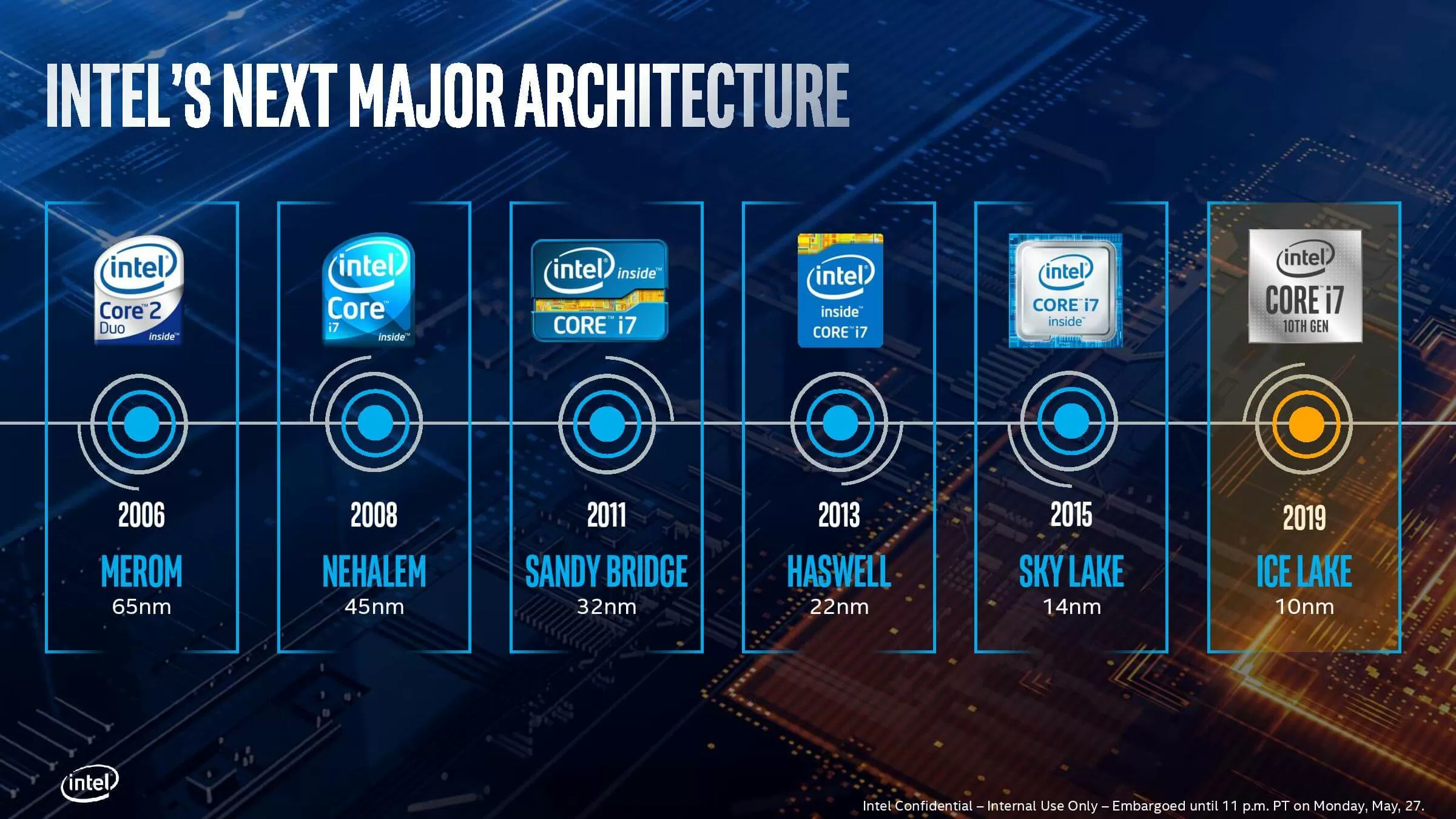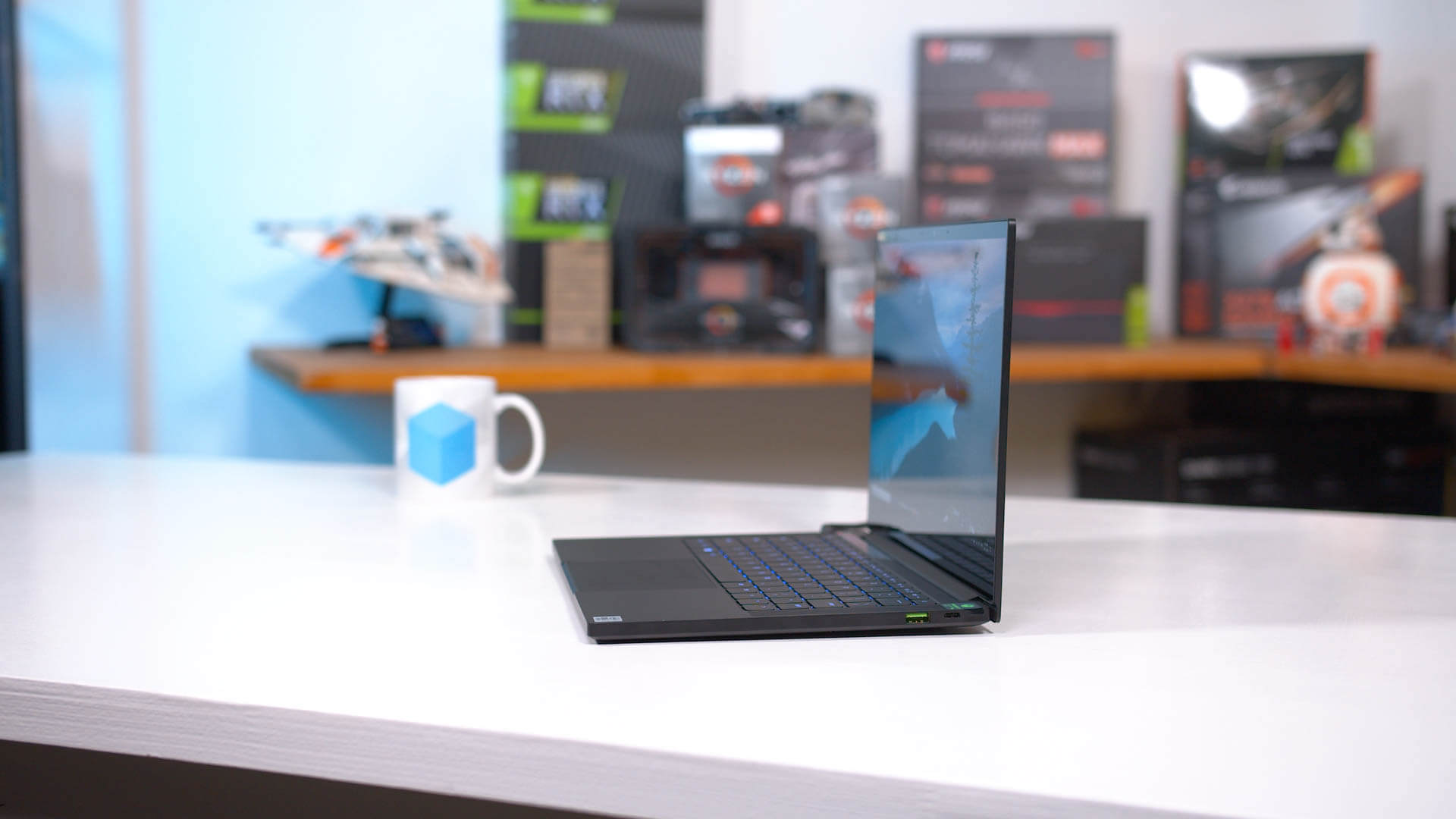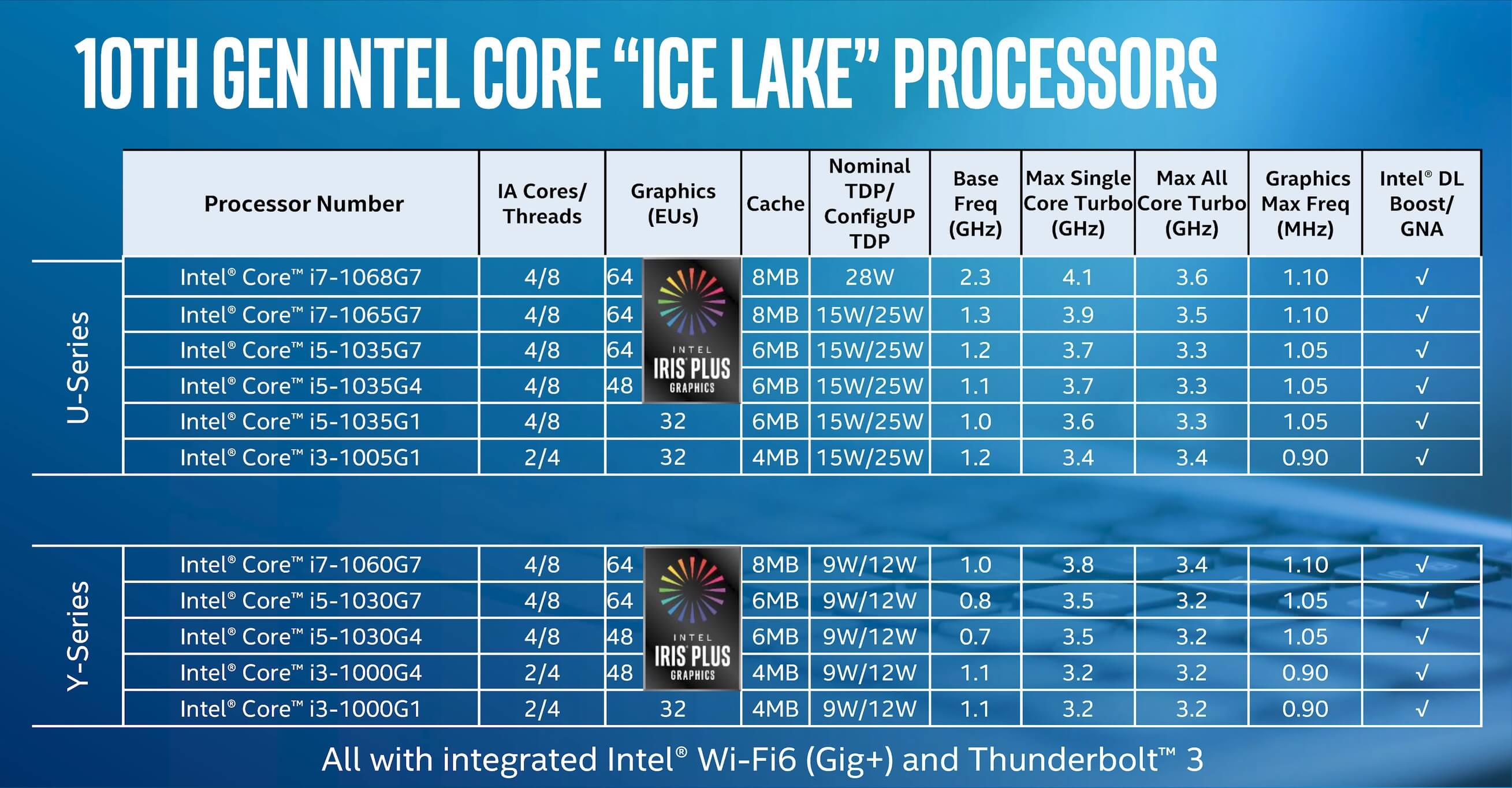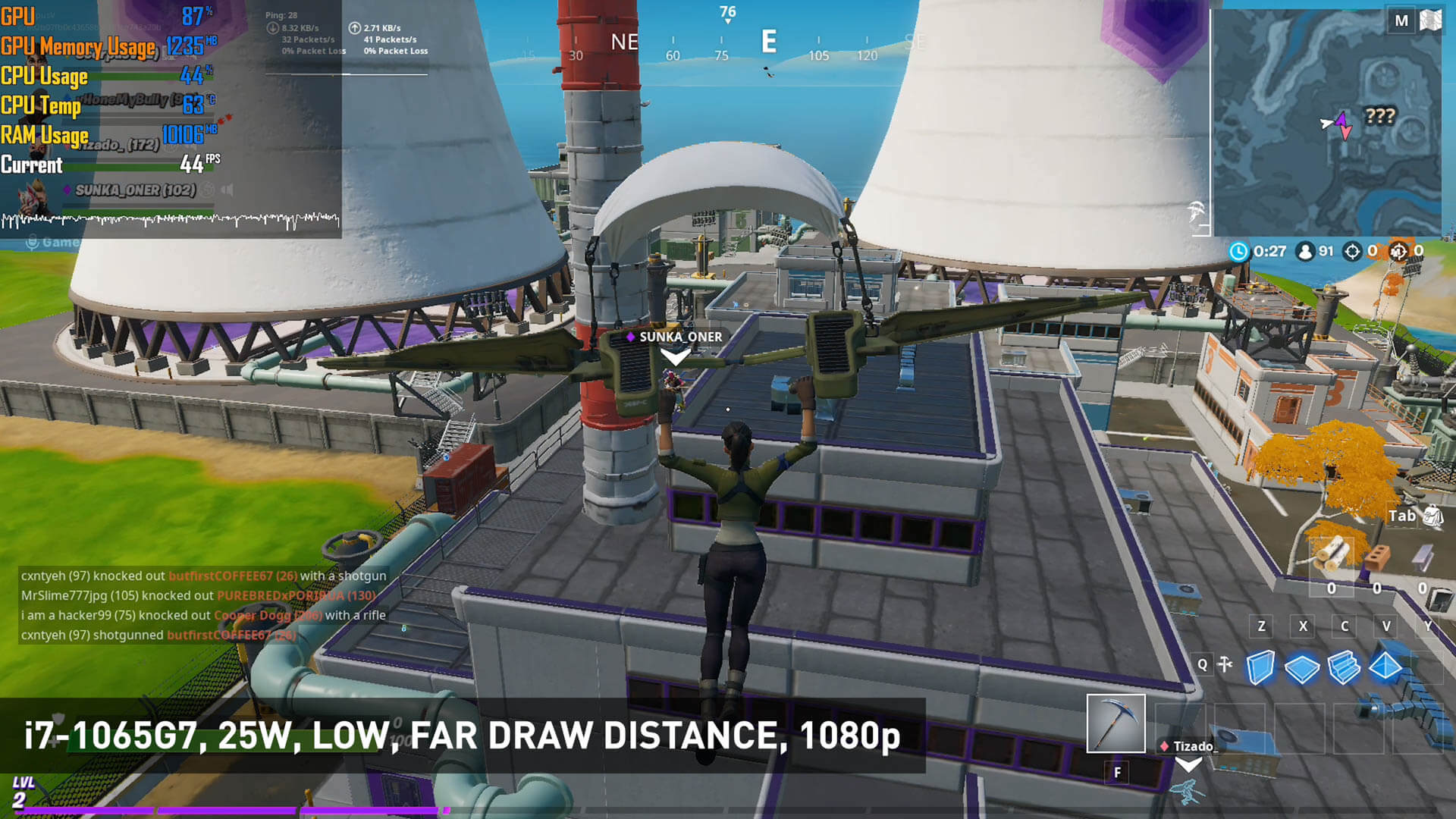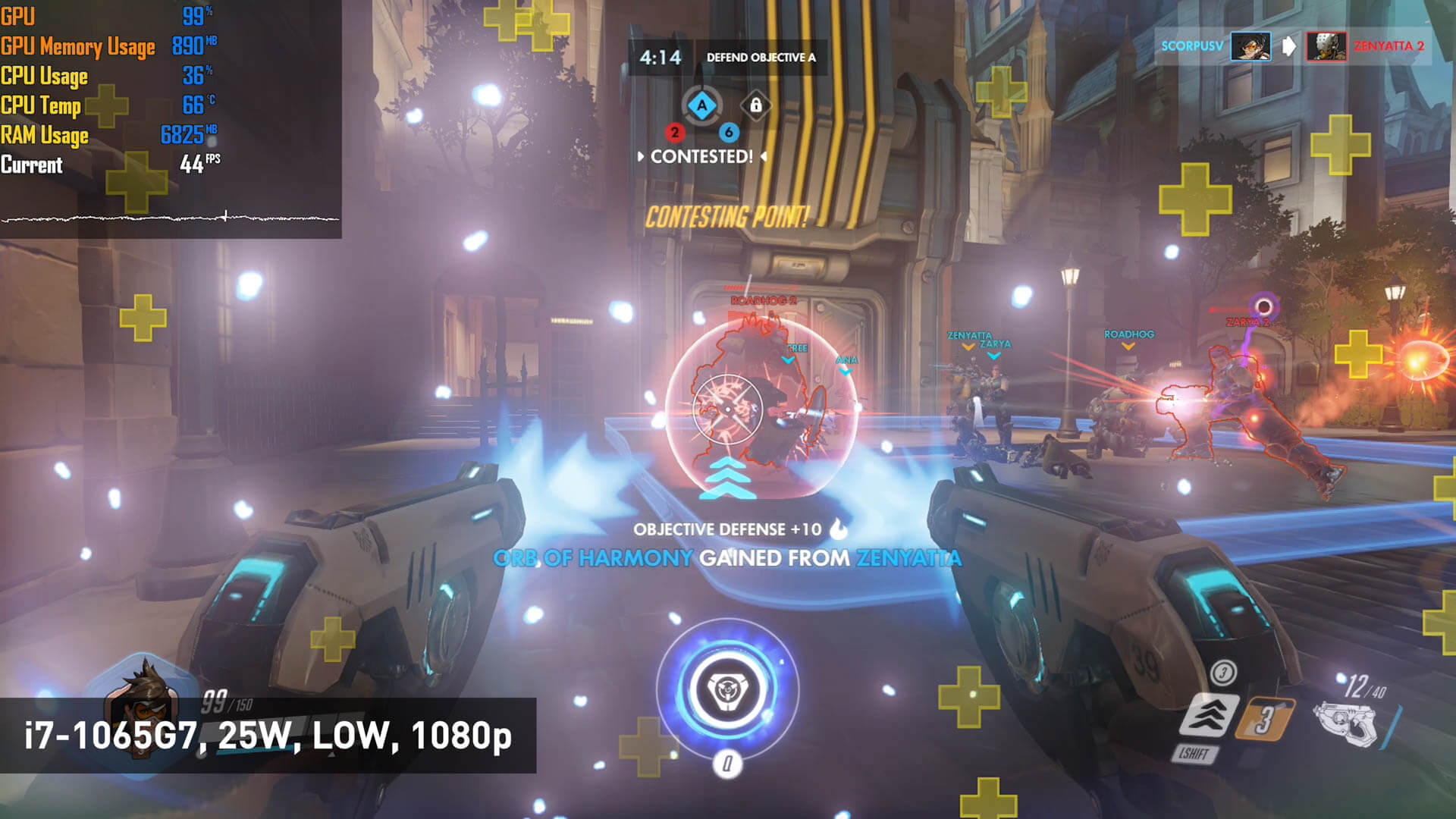After exploring the capabilities of the new Ice Lake Core i7-1065G7 on the productivity side, we're coming back to test the CPU for ultrabook gaming using the G11 Iris Plus integrated graphics. First, a few takeaways from our initial review: as far as multi-threaded applications go, Ice Lake on 10nm isn't offering an upgrade over existing quad-core 14nm Skylake derivates like Comet Lake or Whiskey Lake. From both a performance and efficiency standpoint, in this regard 10nm is a bit of a disappointment.
Second, the Core i7-1065G7 does bring higher single-threaded performance, and crucially for today's review, improved GPU performance. While we haven't covered gaming yet, the new Gen11 GPU design has brought significant gains to GPU-limited and compute-heavy productivity apps, and makes Ice Lake a great choice for some workloads like Adobe Premiere.
Third, it doesn't greatly improve what's been available in ultraportable form factors because you can also find discrete GPUs in 13-inch thin and light systems. But as far as a single-chip solution goes, Ice Lake is quite decent.
Today, of course, we plan to switch gears to take a look at gaming performance. Most ultraportables that use 15 or 25 watt CPUs aren't exactly designed for gaming or have gaming in mind - that's what your bigger 15-inch devices are for - but buyers of ultraportables still might be interested in a bit of casual gaming. Probably not Red Dead Redemption 2 kind of gameplay, but more your Fortnites and Overwatches... those sorts of games should be playable on modern integrated graphics in an ideal world.
But as we know, for years Intel's integrated GPUs haven't been powerful enough to run popular titles like Fortnite or even CS:Go at reasonable but the lowest settings. Why is this, and why so slow for so long? This stems from the hardware they've been using for the past five years.
A brief history of (bad) Intel iGPUs
Since the launch of Broadwell, Intel's first series of 14nm CPUs back in 2014, Intel has been using the same basic GPU design for all 14nm products, right through to current 10th-gen Comet Lake products. Take Intel's Broadwell Core i7-5500U. That launched with Intel's HD Graphics 5500, a GT2 tier GPU with 24 execution units and a maximum clock speed of 950 MHz. The following year we got Skylake with HD Graphics 520, a 100 MHz bump of the same 24 execution unit design.
Then we move through Kaby Lake, Kaby Lake Refresh, Whiskey Lake and now Comet Lake. All use some variant of Intel's HD or UHD 620 GPU, which you guessed it, still pack 24 execution units. The Whiskey Lake Core i7-8565U to cite an example, has that part clocked at 1150 MHz.
Intel U-series CPUs from 2013 to 2019
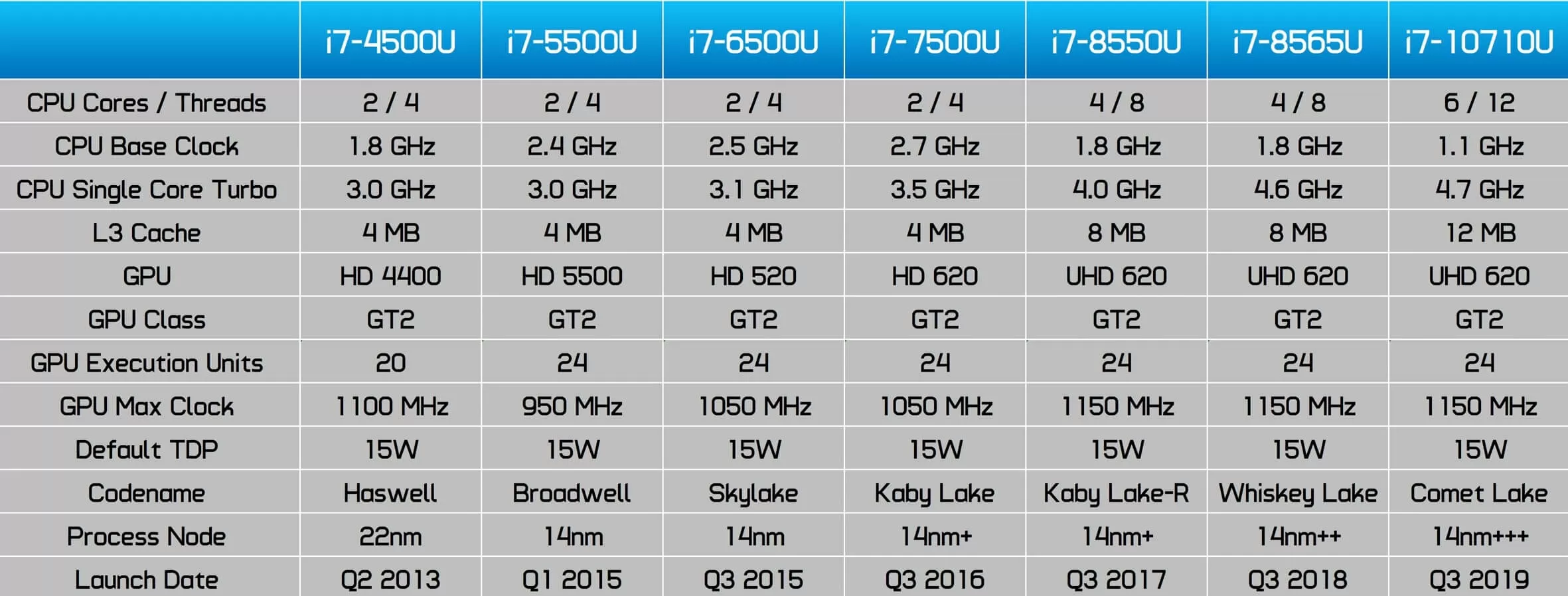
From 2015's Broadwell to Comet Lake in 2019, the only improvement Intel has given to their 15W-class GPU is a clock speed increase of 200 MHz. Four and a half years for 200 MHz is a pathetic improvement, especially given in that time Intel has found a way to increase CPU cores from two to six.
But it gets worse. If you go back to the 4th generation, aka Haswell, it offered 20 execution units at 1100 MHz on 22nm. When you look at the GFLOPS ratings for these chips, Intel was offering 352 GFLOPS of GPU compute power in 2013, and earlier this year in 2019 with Whiskey Lake you were getting 442 GFLOPs. About 25% more raw performance across five and a half years. With that sort of tiny gain, it's no wonder modern ultraportable systems are typically incapable of playing even basic casual games.
Intel needed to do something on the GPU side, especially with AMD offering more powerful graphics with Ryzen Mobile. They were probably hoping to get it out sooner, but with 10nm delays, they've had to wait until 10th-generation Ice Lake parts to launch their new Gen11 GPU design, which brings substantial gains.
Ice Lake's Iris Plus Graphics
Ice Lake now offers three GPU tiers, split by execution unit count. At the top end we have G7 graphics with 64 execution units, G4 with 48, and G1 with 31. G7 and G4 are branded as Iris Plus, a brand Intel has used in the past for more powerful GPU options, while G1 gets the UHD branding.
Clock speeds are similar to what Intel has been doing for a while now, between 900 and 1,100 MHz. But the big gains for Gen11 are coming in the execution unit count, which for the top end G7 graphics is 2.7x higher than with equivalent 14nm CPUs. Even the base G1 tier is faster thanks to a 33% increase in execution units. It's a big jump across the board.
Previously we were talking about Whiskey Lake offering ~442 GFLOPS of compute performance. With Ice Lake's Gen11 GPU at 64 execution units and 1,100 MHz, we're up to 1,126 GFLOPs. That's a massive increase that allows Intel to proudly proclaim this their first 1 TFLOP integrated graphics solution.
Intel U-series CPUs from 2013 to 2019
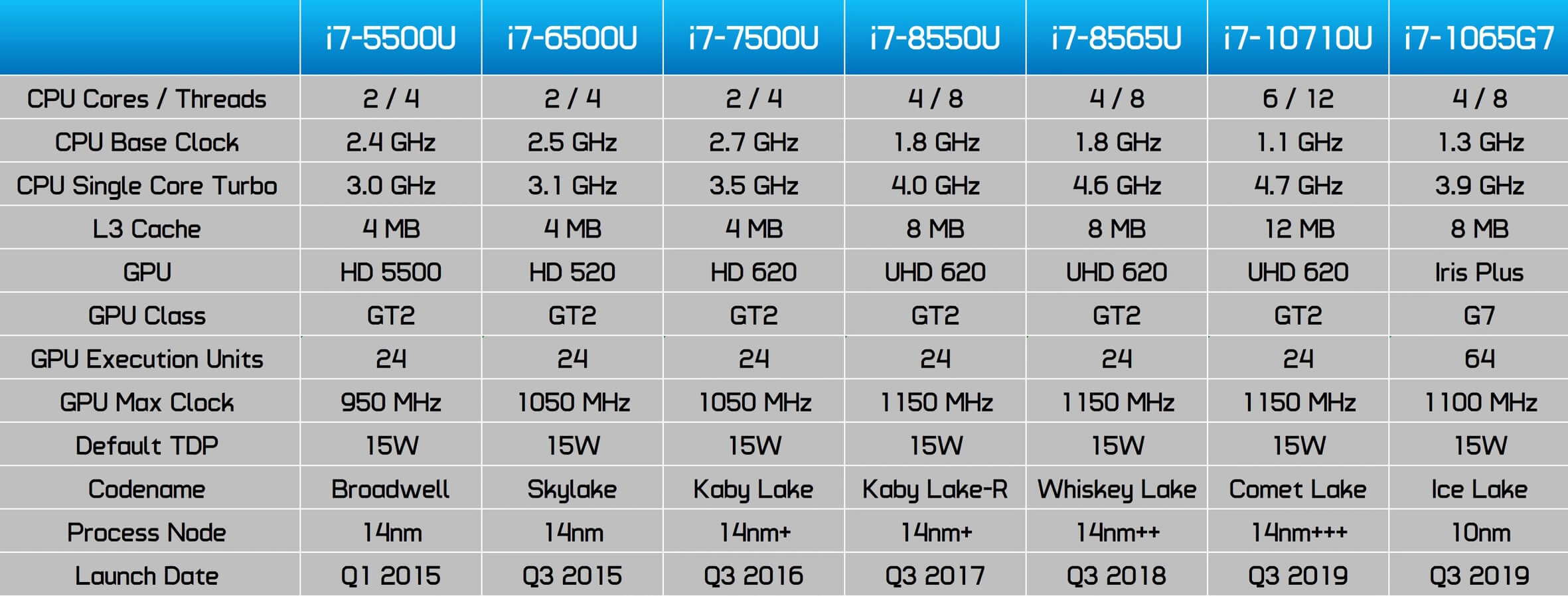
For today's testing we'll be doing some benchmarking of Ice Lake's Gen11 GPU in its fully unlocked configuration, as found in the Core i7-1065G7. Thanks to our test laptop - the Razer Blade Stealth with 16GB of dual-channel LPDDR4X-3733 memory - we can examine how this GPU performs in both 15W and 25W configurations in gaming workloads. We'll also compare it to a range of integrated GPUs and discrete GPUs you can get in ultraportable laptops.
Gaming Benchmarks
First up in our new 15W integrated graphics suite is Rocket League, a game that should be playable on this sort of GPUs. At native 1080p with render detail set to "quality," this should be a playable configuration. However on Intel's older solutions, it really struggles to deliver such, with an average frame rate just above 30 FPS and a 1% low in the 20s. This is a remarkably poor result, but we all know the UHD 620 is slow, so we're not surprised.
With Ice Lake in its 15W configuration, 1% low performance has only crept up slightly, so the experience isn't the smoothest, but average performance is 52 percent higher. However, this isn't the 2.5x to 3x performance increase you'd expect from the difference in raw spec throughput, so what is going on there?
The answer is the 15W power limit is too tight to have the GPU running at its maximum rated frequency. This wasn't as much of an issue with previous 14nm CPUs, you can see there's only a 15% increase to average frame rates when giving the 10710U a 10W power increase. But with Ice Lake, we're seeing gains of 38% for the 25W configuration over 15W. This makes the 25W version much more desirable for portable gaming than 15W.
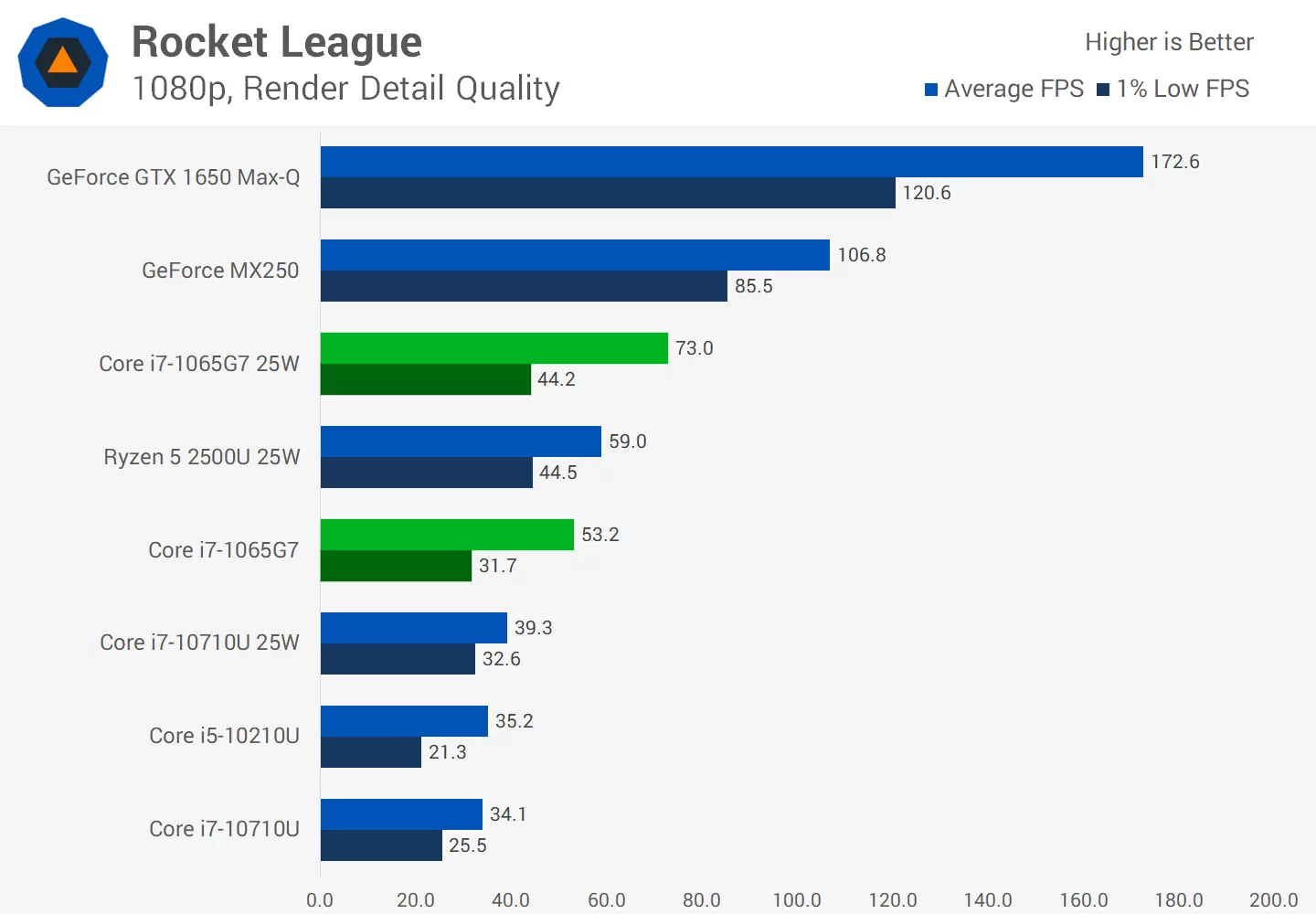
When you compare Ice Lake on 25W to Comet Lake on 25W, it's very favorable for Ice Lake. The 1065G7 is 87% faster, a mighty big increase. We're happy Intel is putting large enough GPUs in their U-series chips now that they see performance gains at 25W, because it makes that 25W configuration more desirable and useful for OEMs. It's also inline with what we already see with AMD GPUs and even Intel's Ice Lake CPUs: more power should equal more performance.
Ryzen is somewhat underrepresented as we only have a Ryzen 5 2500U 25W test system available, with Ice Lake performing around the same mark. AMD does have a more powerful Ryzen 7 3700U on the market, which we suspect will take things up a notch further.

Next up we have GTA V running at native 1080p on the lowest settings. The gains we're seeing here aren't as strong as with Rocket League, we're down to a 44% improvement comparing 15W to 15W, but a decent result for sure. The 25W configuration fares better, coming close to the performance of the Ryzen 5 2500U, and offering about 85 percent more performance than 14nm iGPUs.
Interestingly, in this test, Nvidia's MX250 GPU is significantly faster than Intel's Ice Lake graphics at 25W. The slower 1D12 configuration of the MX150 is only marginally faster, but when the fully fledged MX250 is introduced, it blazes away with almost double the performance. In Rocket League the MX250 was faster as well, but this GTA V test is a bit of an outlier that significantly favors Nvidia's silicon.

Strategy games like Civilization VI are great to play on an ultraportable. Intel's integrated graphics haven't been up to scratch for native 1080p playback in this title, until now. The Core i7-1065G7 scrapes across the line with just over a 30 FPS average at this resolution in the most intensive periods of the game, but this isn't entirely unplayable. We see a 35% improvement comparing Ice Lake and Comet Lake at 15W.
As expected, at 25W the chip has more room to breathe and delivers better results. We're up to a 70 percent performance improvement, however it still falls behind Nvidia's MX250 discrete GPU and Ryzen Mobile here.

Counter-Strike: Global Offensive at 1080p with the lowest settings was not unplayable on Intel's old solutions, but performance was often in the mid 40s with these settings, which is not good for even amateur competition. Ice Lake significantly improves this situation, offering 76% more performance at 15W, and over twice the performance at 25W.
This is also a title where Intel's Core i7-1065G7 is faster than the Core i5-10210U paired with an MX250 GPU. You will need the 25W configuration to beat this discrete GPU pairing, but Intel sees a solid win here.

Gears 5 is a very intensive and future-looking benchmark given we're running at 1080p with medium settings. Ice Lake is significantly faster than previous generation integrated GPUs as many bottlenecks are alleviated here and the GPU isn't choked under the weight of the requirements. With only up to 15 FPS on offer, this isn't a configuration you'll be actually using but an improvement nonetheless.
We're also seeing a fairly standard cadence of performance. At the bottom of the 'reasonable' performance class, we have the 15W Core i7-1065G7. A step up from that is the Ryzen 5 2500U 25W configuration, and then another step up is the 25W Core i7-1065G7. Sitting above all of those is Nvidia's MX250, offering a ~30% performance increase.
This hierarchy is reasonably consistent across the games we've tested so far. The position of Ryzen Mobile fluctuates a bit and we saw in CS:GO that the MX250 can be slower, but generally speaking this is how things lineup in games and synthetic workloads like 3DMark's Time Spy.
Offering significantly more performance than any of these parts is Nvidia's new GeForce GTX 1650 Max-Q, which can be found in 13-inch ultraportables like the Razer Blade Stealth. You can see from the Gears 5 results that the GTX 1650 Max-Q makes medium settings at 1080p in Gears 5 quite playable, and it often delivers more than 2x the performance on offer with Ice Lake's integrated GPU at 25W. So while Intel has been busy making their iGPU half decent, Nvidia has been powering along with new discrete options that take things a step further in ultraportable form factors.
From those five benchmarks, we're starting to get a typical idea of how Ice Lake stacks up. In all but the most GPU constrained situations, the 64 execution unit configuration is around 50% faster than previous generations with 24 execution units, when compared at 15W. When that's bumped up to 25W, the gains are larger, with over 80% improvement over 14nm equivalents.
Playable performance, or not?
Considering previous generations of integrated graphics are painfully slow, this begs the question: do these gains actually make modern titles playable on integrated graphics? To answer that, we'll need to look at more titles.
Out of the games tested so far, Rocket League and CS:Go are comfortably playable at native 1080p with the lowest settings. We'd say Civilization VI is also playable, with GTA V in a borderline state. Gears 5 at medium settings is a no go.
Turning everything down to the lowest settings and setting a resolution scale of 900p on Gears 5, the game still didn't achieve a consistent 30 FPS during the benchmark, and in fact to keep up to that minimum requirement it typically ran at 72% of 1080p. It looks absolutely terrible, too, so we'll say the game is unplayable on Ice Lake.
Other modern triple-A games we tested showed something similar (25W configuration). Shadow of the Tomb Raider had to be run on the lowest settings to achieve 30 FPS, and it wasn't pretty. Resident Evil 2 is a game that runs really well on decent discrete GPUs but is completely unplayable on integrated graphics. At low settings and a pixelated experience, we still couldn't hit 30 FPS.
The Division 2 is a beautiful game but unfortunately it doesn't run well on integrated graphics either. F1 2019 we'd class as borderline playable. At 900p on the 25W configuration, or 720p on the 15W version, I was able to hit above 30 FPS using the lowest settings. Ideally you'd want 60 FPS in a game like this, but we guess you'd take above 30 FPS on integrated graphics. The Outer Wilds was also often dipping below 30 FPS and the game felt really sluggish.
With that we've safely established that graphically intensive titles are generally going to be unplayable on integrated graphics. How about popular and often less GPU intensive competitive games?
Rainbow Six Siege is a mixed bag. At 15W, we barely hit 30 FPS using low settings at 720p. At 25W and a 900p render resolution, we were getting around 40 FPS in the benchmark, so this is borderline playable and perhaps could be tuned more with further resolution downscaling.
Apex Legends is straight up unplayable, the stuttering is awful.
There's better news for Fortnite though. At a native 1080p with the lowest settings and a far view distance, the 25W configuration pretty comfortably does 45 to 55 FPS and looks decent when doing so. It's not the best experience, but if you want to hop into a Fortnite match on your ultraportable, we'd say this is fine.
At 15W, things get a little dicey. Native 1080p on the lowest settings is a 30 FPS experience. With an 80 percent resolution scale, we were able to run the game around 35 to 40 FPS.
And finally we've got Overwatch. This is one of the better games for integrated graphics, running at between 40 and 60 FPS on the 25W configuration at native 1080p with the lowest settings.
Conclusion
Starting with the positives, Ice Lake is definitely providing a significant performance uplift over last-generation integrated graphics solutions from Intel, and this translates into much better gaming performance. A 50% improvement at 15W, and more than 80% at 25W, is nothing to sneeze at given how few gains we've seen over the past six years. Adding more execution units into the mix was the right choice.
This makes G7-tier Ice Lake suitable for playing many popular casual and competitive games where previous generations of integrated GPUs struggled to deliver acceptable performance. Titles such as Rocket League, Overwatch, CS Go and Fortnite are playable on this GPU in either its 15W or 25W configurations.
Older titles from 5+ years ago are also more playable on Ice Lake than previous Intel CPUs, while games like Civilization VI that we think are great for laptop gaming, have also become playable with the new Gen11 GPU. Sometimes you'll need the 25W configuration to get a decent experience in these titles, but at least we are now getting increased GPU performance when OEMs choose to enable the 25W mode.
That's great news for those who want to use their ultraportable laptop for a bit of light gaming on the go. It's not earth shattering performance, but gameplay at low settings and some resolution scaling, but for slim and light systems, we think that's acceptable. It also means you don't absolutely need a discrete GPU for gaming, which previously was essential on Intel notebooks. OEMs can now opt for a one-chip solution that's semi-decent in this arena.
However there are also areas that are less impressive. Ice Lake performs similarly to AMD's Ryzen Mobile: the 25W configuration of the Core i7-1065G7 is somewhat faster than AMD's Ryzen 5 2500U. This means Ice Lake doesn't really move the needle on what is possible in a single-chip design. If you wanted this performance without a discrete GPU, the option has been there from AMD since the launch of their Ryzen APUs – the Core i7-1065G7 will be faster in CPU demanding tasks however.
A bigger problem for Ice Lake is that it fails to be a compelling option against Nvidia's low power discrete GPUs. Nvidia's MX250 in its standard configuration is a step above the 25W Core i7-1065G7 for gaming, even when paired with a 15W CPU. It doesn't enable a drastically different tier of performance given most triple-A titles are still unplayable on an MX250, but the titles we've just been talking about like Fortnite and Overwatch do run better.
Having an MX250 alongside a 15W U-series CPU likely consumes more power. But what's important in a laptop isn't raw TDPs or power consumption, it's what is possible within a certain form factor, given most performance intensive tasks like gaming are (or at least should be) run while plugged into the charger. The ultimate goal is getting something that's super portable, while also being super powerful when it needs to be.
If you look at the market for 13-inch ultraportables these days, there are plenty of options with an MX250 that challenge pure Ice Lake systems on both price and portability, while offering superior performance. A couple of years ago this was rare, but in 2019, makers are easily integrating MX series GPUs without compromising the form factor.
The fastest ultraportables are also integrating Nvidia's GTX 1650 Max-Q. The latest Razer Blade Stealth is the perfect example: this is still a super portable laptop, but it has no trouble adding in a 35W discrete GPU. The end result is at least twice the gaming performance of Intel's 25W Ice Lake configuration with G7-tier graphics. Granted, it's also a more costly option.
Normally we wouldn't bother pointing out that discrete GPUs are faster. That's obvious. But Intel's 10th-gen is in an interesting place where both Ice Lake and Comet Lake are on the market. The entire selling point for Ice Lake is its faster GPU, but it's not fast enough to make it a good option over a six-core 14nm Comet Lake CPU paired with a low power discrete GPU. That sort of configuration will offer better productivity and better graphics performance, and it doesn't even require a new architecture or manufacturing node. And it's all possible in the same form factors Ice Lake targets.
That's not to say Ice Lake is pointless. OEMs that don't have enough space, thermal or power budgets to accommodate both a U-series CPU and discrete GPU will get the best graphics performance from Ice Lake while also receiving a capable CPU.
As Intel forges forward with 10nm designs we suspect most of these issues we're seeing with the 10th-generation lineup will be alleviated. A future six-or-more-core 15W part with Xe graphics will end the life of 14nm, while hopefully competing with upcoming Ryzen APUs and eliminating the need for MX series discrete graphics. That's what we hope happens, it's up to Intel to execute.
